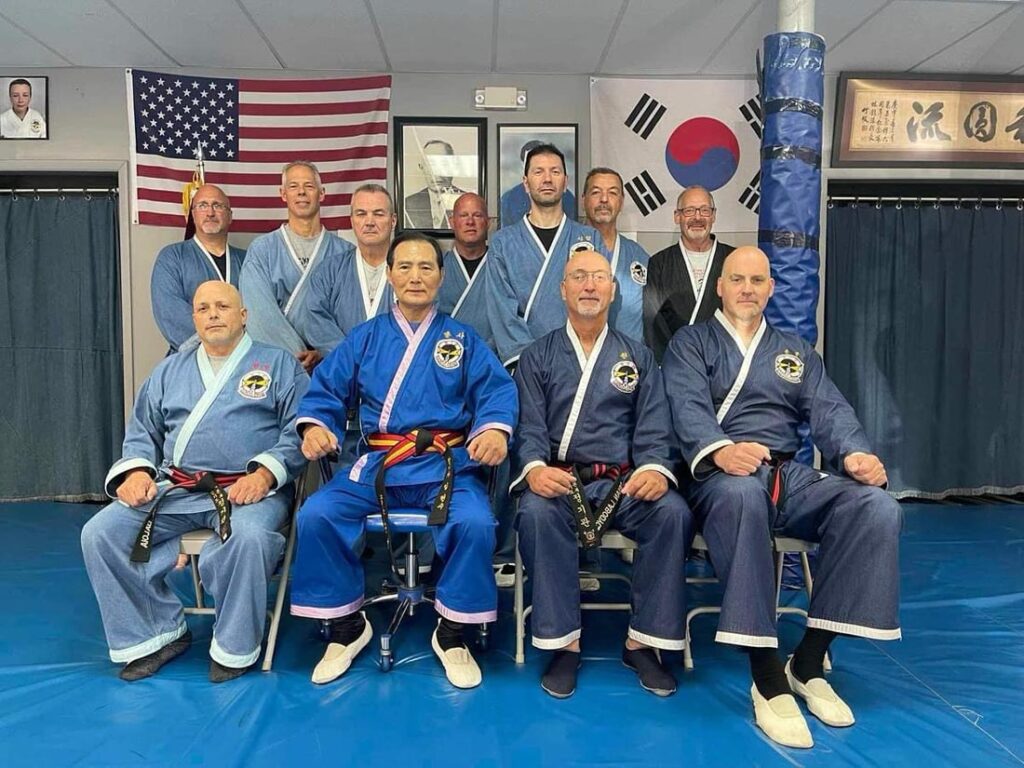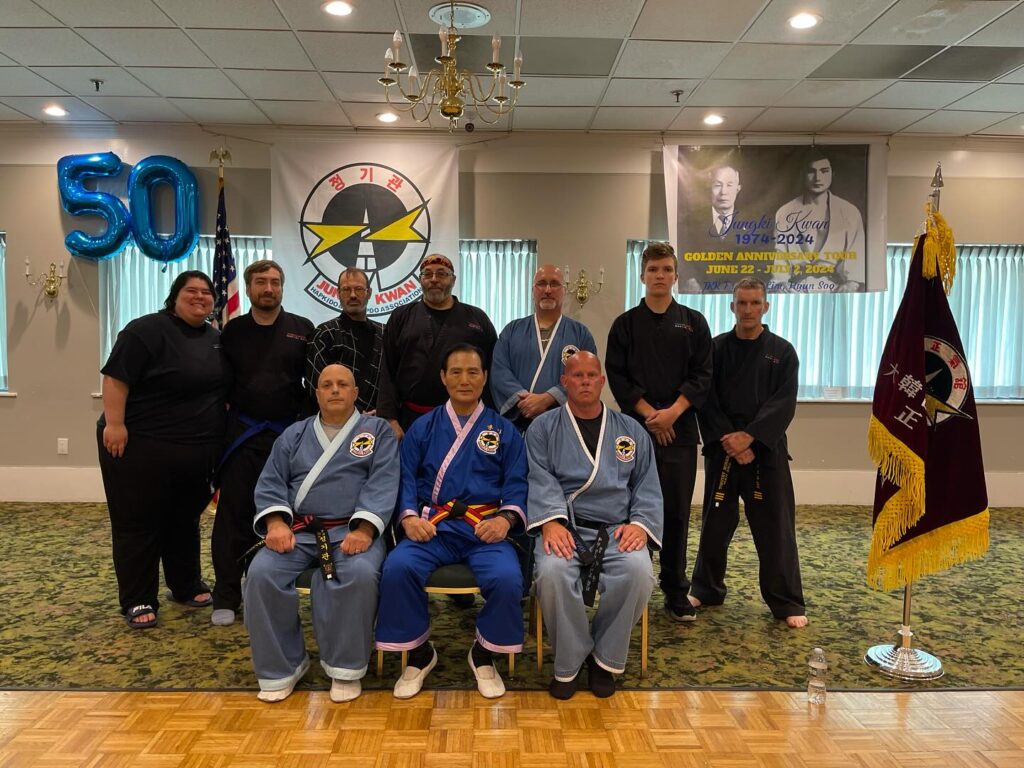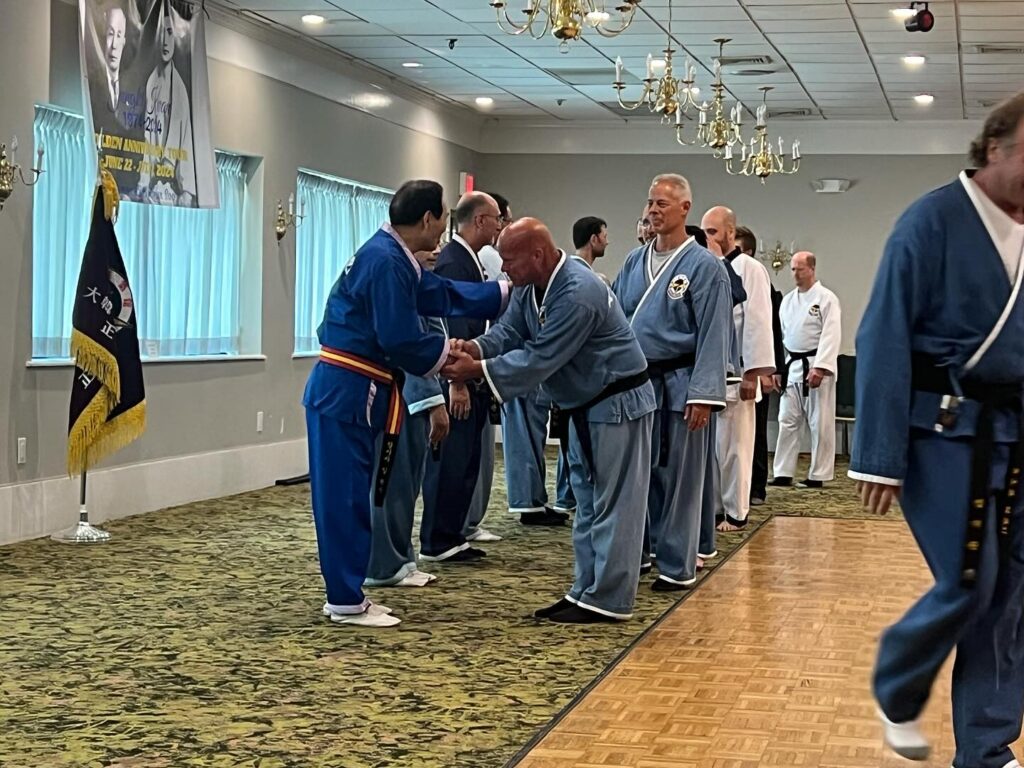This year celebrates the 50th anniversary of Jungki Kwan, founded by Grand Master Lim Hyun Soo. Grand Master Lim is a 9th Dan direct student of Hapkido’s founder, Choi Yong Sul. In 1974, with Choi’s blessing, GM Lim opened his Dojang and has since dedicated himself to spreading the teachings of Choi’s original Hapkido worldwide. This milestone is a testament to a remarkable and historic journey. The following blog chronicles the incredible week I spent training with Grand Master Lim Hyun Soo.
Inner Power Martial arts is proud to be a member of the World Jungki Hapkido Association .

Day 1: Emphasizing Strong Foundations
Our journey began with a special training session led by Grand Master Lim, who emphasized the importance of maintaining strong and proper stances. He taught us the nuances of weight distribution, explaining that stances should be comfortable and natural, with knees bent. The main takeaway was to be soft when encountering a strong attack and strong when the energy is weaker, highlighting the balance of Yin and Yang.
GM Lim shared insights on footwork, emphasizing the use of 45° and circular movements. He even recounted a challenging drill from his training with Choi Young Sul, where he had to keep his knees bent while walking in all directions.

Day 2: Exploring Jungki Hapkido Rocking Drills
The day was divided into a morning and an afternoon session, each offering a deep dive into essential drills and the philosophical underpinnings of Hapkido.
The morning session focused on the Jungki Hapkido rocking drills and exercises, a cornerstone of our training at Inner Power Martial Arts. These drills are vital for developing balance, coordination, and the effective use of energy. Grand Master Lim guided us through various techniques, emphasizing the importance of each movement. We practiced blade-to-blade arm movements, circular motions, pulling, and breath holding.
Grand Master Lim illustrated how these drills embody the same principles as sword techniques (Kuhapdo) and highlighted their application in empty-hand Hapkido techniques. He demonstrated each drill both with and without a sword, ensuring that we understood the connection between these practices.
Practical Applications: Punch Defense and Energy Redirection
We then transitioned to applying these drills in punch defense scenarios, focusing on off-balancing and redirecting an opponent’s energy. This practical application reinforced the core principles of Hapkido and provided a deeper understanding of how these techniques can be utilized in real-world situations.
Afternoon Session: Circle Principle in Hapkido
The afternoon session covered the circle principle of Hapkido, a fundamental concept that differentiates Hapkido from other martial arts. Grand Master Lim explained the utility of both large and small circles in taking an opponent’s balance. He shared historical insights, noting that Choi Yong Sul, the founder of Hapkido, used 70% small circles and 30% large circles, whereas Morihei Ueshiba, the founder of Aikido, preferred 70% larger circles and 30% smaller circles.
Interactive Session: Q&A and Practical Demonstrations
Grand Master Lim encouraged us to ask questions and was very welcoming in his responses. He reiterated the distinction between basic (learning) techniques and fighting (using) techniques. Basic techniques are crucial for building a solid foundation, while fighting techniques leverage an opponent’s energy for effective combat.
One of the most memorable moments was when Grand Master Lim invited me to grab him while he demonstrated an outside wrist lock (#2). Before I knew it, I was on the ground, my wrist twisted in a knot. His execution was fast and precise, yet controlled to prevent injury, showcasing the effectiveness of small circle techniques.




Day 3: Ki Development and Practical Techniques
The morning session saw a larger group of participants than the previous days, with many masters joining us from different states to learn and train under the esteemed Grand Master Lim.
Morning Session: Junki Kwan Exercises and Their Importance
Grand Master Lim began the day by reviewing all the Junki Kwan exercises and explained how they should be practiced, emphasizing the significance and meaning of each exercise. He highlighted that these exercises are fundamental for developing Ki (energy) and stressed that they should be incorporated into every class for at least 10 minutes.
Here are the exercises we focused on:
- Basic Hitting: Practicing strikes to develop speed and precision.
- Cross Hand Hitting (Inside/Outside): Enhancing coordination and reaction time.
- Punching (High and Low): Building strength and accuracy in delivering punches.
- Punching Fighting: Combining punching techniques in a fluid, combative context.
- Cross Hand Variations:
- Strong and Slow
- Fast
- No Touch
- Stepping Forward
- Stepping Opposite Forward
- Back Same
- Back Opposite
- Same Hand Variations: Executing techniques with the same hand in multiple directions and speeds.
- Pulling: Developing the skill of using an opponent’s force against them.
- Outside Wrist Stretch with Footwork: Practicing movement in various directions to improve flexibility and balance.
- Rocking Exercises: Including blade, forearm, large and small circles, pulling, and breath holding to integrate movement with energy control.
Grand Master Lim emphasized that these exercises are designed not only to build physical skills but also to enhance mental focus and energy flow, which are essential components of Hapkido.
Afternoon Session: Practical Applications and Korean Etiquette
In the afternoon, we delved into practical applications of the techniques we had been practicing. We reviewed Son Mok Soo (set 2 of white belt) and executed each move following the same format as the morning drills, incorporating steps such as:
- Stepping across
- Moving backwards
- Circular footwork
- Applying the shocking (striking) principle
Grand Master Lim illustrated that all the basic Jungki Kwan Hapkido techniques, from white belt through black belt, are like roots of a tree. Each root can branch out into ten or more variations, showing the depth and versatility of the techniques.
During this session, I had the opportunity to experience Grand Master Lim’s technique firsthand. While teaching the outside wrist lock #2, he called me up to demonstrate. Before I realized what had happened, I found myself on the ground, my wrist twisted in a knot. His technique was incredibly fast and powerful, yet he took care not to injure me, showcasing the control and precision that comes with mastery.
Korean Etiquette
Grand Master Lim also educated us on traditional Korean etiquette, emphasizing the cultural aspects that are integral to martial arts practice. He outlined the following points:
- Standing While Receiving Instruction: One should stand straight with hands crossed in front of the stomach. This posture shows the highest respect.
- Hand Shaking: Should be done with two hands while bowing slightly to show respect to your teacher.
This lesson on etiquette was not only fascinating but also a reminder of the cultural heritage and respect that underpins martial arts.
Reflections and Anticipation
Day 3 was filled with invaluable lessons and insights that deepened our understanding of Hapkido’s principles and techniques. The combination of practical drills, historical context, and cultural etiquette made for a comprehensive and enriching training experience.
As we moved forward to Day 4, there was a palpable sense of anticipation and excitement among all participants. The knowledge and skills imparted by Grand Master Lim were not only shaping our physical abilities but also fostering a profound respect for the art of Hapkido and its traditions.
We eagerly looked forward to continuing this journey of learning and growth, grateful for the opportunity to train under such a distinguished master.

Day 4: Core Principles of Hapkido
On Day 4 of our special training seminar, Grand Master Lim spoke of the three core principles of Hapkido: Push, Pull, and Circle. He explained how these principles, which originate from Daito Ryu Aiki Jujitsu, were shared by the founders of Hapkido, Aikido, and Judo, all of whom studied under Sokaku Takeda. While the core principles remain consistent, the application differs across these martial arts. Judo has been modified for sporting competition, Aikido employs larger circular movements, and Hapkido, as taught by Choi Yong Sul and Grand Master Lim, retains the original methods.
Grand Master Lim emphasized the correct technique for gripping, advising that grabbing should primarily involve the bottom three fingers (pinky, ring, and middle), providing 70% of the power, with the thumb and pointer finger contributing the remaining 30%. This grip is also essential when holding a sword. He compared this to a golf swing, highlighting the importance of proper grip in executing effective techniques. Numerous historical photos of Choi Yong Sul demonstrate this grip.

The day included a thorough review of the basic Jungki Hapkido exercises, which are fundamental to developing good technique. Grand Master Lim stressed the importance of practicing these exercises regularly, as they form the foundation of all Hapkido movements. The connection between these exercises and effective technique was made clear, underscoring their significance.
Reflecting on the day’s lessons, it was evident how vital these principles and exercises are for mastering Hapkido. The week has been incredibly insightful, and we eagerly anticipate the testing and larger Kuhapdo and Hapkido seminars over the weekend.
Weekend Seminars: Core Principles and Advanced Techniques
The weekend culminated in extensive Kuhapdo and Hapkido seminars. GM Lim reiterated the importance of practicing basic techniques, emphasizing that generating energy from a neutral position is more challenging than using an opponent’s energy in combat. We learned about the five core principles: Basic, Pushing, Pulling, Circle, and Shocking (striking). GM Lim shared personal stories and demonstrated advanced techniques, including Choi Young Sul’s favorite hand strikes and kicks.


Recap of GM Lim’s Kuhapdo and Hapkido Seminars
After an intensive week of spending four hours a day on the mat with Grand Master Lim, his consistent message to all Jungki Kwan members, including the higher Dan (Blue Dobok) students, was clear and profound. He emphasized the critical importance of practicing basic techniques. While these foundational movements are more challenging and demanding to master, they are essential for building a strong martial arts foundation. Starting from a neutral position, one must generate energy to off-balance the opponent, a concept that contrasts with the more advanced “using” techniques, which involve leveraging the opponent’s energy.
The core principles of Hapkido that GM Lim highlighted are:
- Basic
- Push
- Pull
- Circle
- Shocking
On Sunday morning, GM Lim covered the intricacies of Jungki Hapkido hand strikes as taught to him by Choi Yong Sul. Choi’s preferred hand strike targeted the throat, a technique known for its effectiveness, while his favorite kick, the scorpion kick, aimed for the groin. During his training with Choi, these strikes were frequently used to instill their effectiveness. As practitioners age, high kicking becomes increasingly difficult, making these targeted strikes more practical and effective.
GM Lim also drew parallels between the principles of swordsmanship and Hapkido, noting that they share the same foundational concepts. Practicing with the sword not only improves Hapkido skills but also reinforces the understanding of these principles. Hapkido is essentially the empty-hand combat counterpart to sword techniques.
Practicing the Junki Kwan exercises, or drills, is crucial for developing and discovering these principles. These drills can be applied to basic core movements, creating a myriad of possibilities. Attempting to document all the techniques and variations would result in an overwhelmingly large volume.
One of the most significant takeaways from this past week is the realization that, as American (western) students, there is a tendency to box ourselves into thinking that the basic techniques are the only way. GM Lim’s teachings encourage us to expand our thinking and explore how different principles can be applied to each technique.
Hapkido is not something that can be learned quickly; it requires years of dedicated practice to truly understand and master. There is a distinct difference between merely learning Hapkido and genuinely understanding it.
Thank you, Grand Master Lim, for sharing your invaluable knowledge with us this week. Happy 50th anniversary to the Jungki Kwan.








